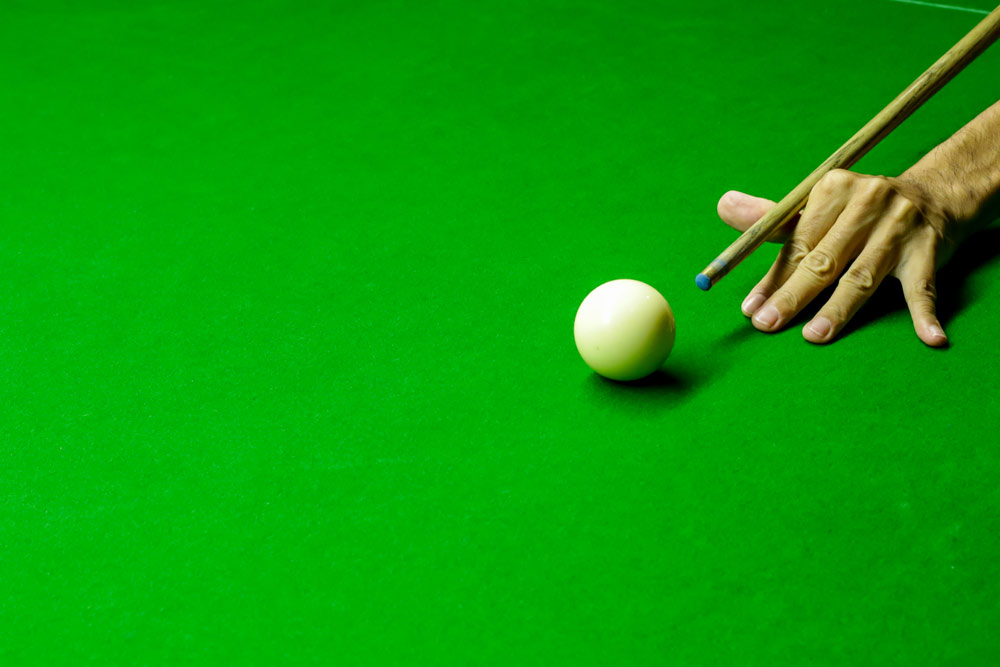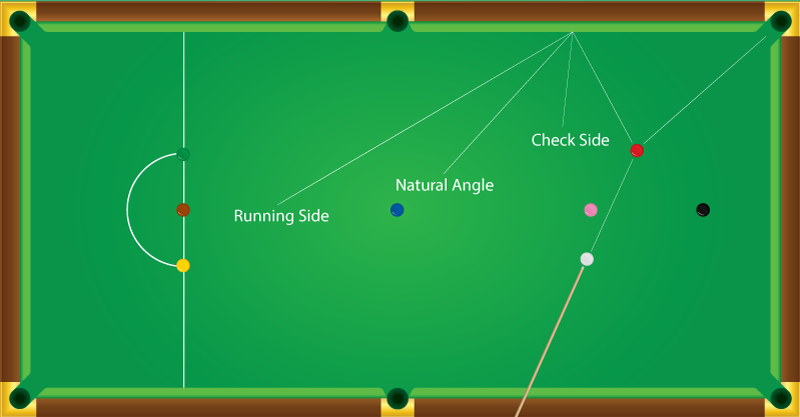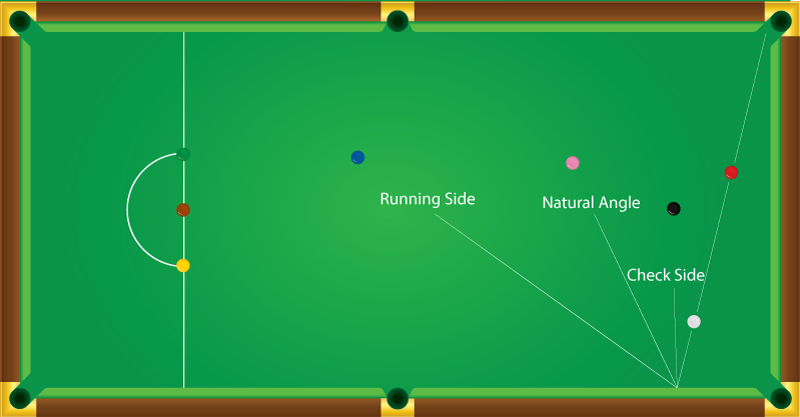In short, yes, snooker players do use side spin and it can be used for a variety of reasons. In fact, side spin is used in virtually every cuesport, including English pool and American pool, where it is known as “English”. In this article I’ll go over everything to do with side spin.

In snooker, side is simply short for sidespin, and it is basically when a player causes the white ball (or cue ball as it is commonly known) to spin (to the left or the right) after hitting it. A player normally applies sidespin on purpose in order to achieve a desired position with the white ball.
However, side can also be imparted by accident and this can cause the player to miss the shot. A shot played with sidespin needs to be aimed differently than a shot played without sidespin. For this reason, side is usually only played on purpose by very accomplished players. I won’t go over how to play a shot with side, I’ll cover that in other article. But I’ll go over the different types of side and the situations they are used in.
When sidespin is used purposefully, it is usually referred to as “playing with side” or “having played a shot with side”. When the sidespin is by accident, this is usually referred to as “imparting unintentional side”.
Unintentional side can be caused by incorrect alignment or by not cueing in a straight line. Even if you setup to the shot perfectly, if the cue is not delivered in a straight line, unintentional sidespin will be imparted and the ball will not travel on its intended path. Combined with the size of the table, this is one of the factors that makes snooker such a difficult game.
In American pool, side or sidespin, is actually referred to as “English”. Although it has a different name, it works in much the same way. The usage of the word is thought to have come from British players who were using sidespin as a result of taking advantage of the newly developed leather tips.
There are 3 different ways in which side effects the cue ball. The effect that a player intends to use depends on the type of shot they are trying to achieve. Let’s go over these 3 different types of side.
The main situation where intentional side is used is when a player is playing off the cushion (or rail as it is known in American pool) during the shot. When the cue ball is spinning as it hits a cushion, it changes the angle and the speed at which it comes off the cushion.
In this way, side is used by accomplished players to achieve a desireable position of the white which would not otherwise be possible. There are 2 different ways in which the sidespin can effect the interaction with the cushion, depending on which way the cue ball is spinning.

The diagram above shows how the player can manouver the white ball into different directions off the cushion, depending on which type of side they use.
These 2 different types of (cushion) side are known as running side and check side. We’ll come back to these later.
Another way in which side effects a cue ball is that it can cause it to swerve. This can be used to a players advantage, particularly when they are in a snooker. Instead of using cushions to escape a snooker, they may be able to use side to swerve around the blocking ball.

The diagram above shows how a swerve could be used to escape a snooker. In this particular shot, left-hand side would be used (as shown by the cue aiming left of centre on the white) to achieve the desired swerve. Typically, some backspin is also used with this shot to help the white grip the cloth, this exaggerates the swerve.
It is worth mentioning that the swerve is not an easy shot to play as it requires a great deal of judgement. The cue ball has to have a lot of spin on it for this effect and it also has to be played slow enough for the spin to grip the cloth and produce the swerve. It is this combination of extreme spin and controlled speed that makes the swerve such a difficult shot to play, even for professionals.
The final way in which side effects the shot, is that side changes the potting angle. Basically, the side on the cue ball “flicks” the object ball (the ball that the cue ball hits) towards the direction of the spin.
The result is that even though the cue ball may travel on a straight path, the spin causes the balls to travel on a different path, particularly the object ball (the ball that the white is hitting).
This effect is one of the main reasons why playing with side is so difficult, the player has to account for this change in angle. A great deal of feel and experience is needed to successfully allow for it.
However, this effect is sometimes used by accomplished players to make a pot which would otherwise not be on. Take a look at the diagram below.

In the diagram above, the pink is blocking the potting angle of the red. Without side, the player cannot pot the red. But if the player uses left-hand side (as shown by the cue aiming left of centre on the white), they can widen the angle and make the pot.
It is worth noting that the cue ball doesn’t swerve in this shot, it is the spin on the white that “flicks” the object ball (the red in this case) onto a different line. But like the swerve, this is quite a difficult shot to judge and is generally only used in situations where difficult positional play is not required. In snooker, using side for this effect is often referred to as “turning the ball over”.
It is worth noting here that the best players in the world will often use side to achieve 2 or 3 of these effects at once. One reasonably common example is when escaping from a snooker.
They will often play a swerve onto a cushion in order to create the desired angle to escape the snooker. This works in 2 ways: firstly, the swerve allows the player to hit the cushion at an angle that wouldn’t otherwise be possible. But secondly, they play the shot in such a way that the cue ball is still spining when it makes contact with cushion. This means that as well as entering the cushion at a different angle, it also leaves the cushion at a different angle.
These shots are very difficult to judge so players will generally only play them when absolutely necessary. But I think it goes to show just how skilled the top professionals are.
So now we’ve done an overview of sidespin, lets go into the 2 most common types of side: running side and check side. These types of side are only using when the cue ball’s path is making contact with a cushion, particularly after making a pot. Depending on whether the player uses running side or check side will change the angle that the cue ball comes off the cushion.
An important thing to understand first is that depending on the situation, a player may need to make the cue ball spin to the left or the right to achieve running side. The same is true for check side.
The names don’t simply mean whether the ball is spinning to the left or the right. They refer to the way in which they make the cue ball interact with the cushion.
I’m sure this sounds confusing but hopefully it will all make sense soon.
With running side, after making contact with a cushion, the white ball takes a wider angle and travels further and than it otherwise would. The easy way to remember this is that running side make the cue ball run further (after hitting a cushion).
For this reason, running side is often used when the cue ball is required to travel a large distance across the table.

The diagram above shows the difference in angle and distance with running side. The “natural angle” (without any side) takes the white ball towards the blue. With running side, the white takes a wider line and runs further, towards the brown and yellow balls. In this example, running side would be left hand side (as shown by the cue aiming left of centre on the white).
With check side, after making contact with a cushion, the white ball takes a narrower angle and travels a shorter distance than it otherwise would. The easy way to remember this is that check side causes the cue ball to “check up” or slow down (after hitting a cushion).
Therefore, check side is often used when a player has too much angle on a shot, and doesn’t want to cue ball to travel too far.

The diagram above shows how check side narrows the angle and reduces the distance the cue ball travels. In this example, check side would be right-hand side (as shown by the cue aiming right of centre on the white).
The diagram below shows the same example but with lines for both running and check side. Hopefully it illustrates how many more options a player has when playing with sidespin.

Notice that in this particular example, the natural angle isn’t very useful as it travels directly towards the blue. By using running side, the player could choose to play up the table for one of the baulk colours (yellow, green, or brown). Alternatively, they could use check side to “hold” the cue ball for the pink (or a long blue).
In snooker, reverse side is a form of check or running side. It occurs when a sidespin shot is also played with backspin, or screw as it is also known. The backspin causes the cue ball to reverse away from the object ball, and there is enough sidespin on the shot that when the cue ball hits a cushion, the side takes effect.
Essentially, a shot that would normally be running side is actually check side when played with screw, and vice-versa. The spin is the opposite of what it would normally be, which is why it’s called reverse side.
The reason why the spin is opposite is simply because the cue ball is travelling backwards. But other than that, the principles of reverse side are the same as regular side.
Reverse side is most commonly used when a player has finished too straight on a pot, which means they don’t have many options for positional play. But by screwing into a cushion and using reverse side, they are able to achieve a much wider range of positions with the cue ball. Take a look at the diagram below.

In the diagram above, we can see that screwing into the cushion without side (centre ball) would cause the cue ball to travel towards the pink, this is the natural angle. By using running side, the player could get the cue ball to travel towards the blue. With check side, the player could get the cue ball to travel towards the black.
In this example, running side would actually be right-hand side and check side would be left-hand side. Notice that this is the opposite of the previous examples. And this is because the cue ball is travelling backwards (towards the cushion) so the spin is effectively reversed – hence the name “reverse side”.
Essentially, running side widens the angle and speeds the cue ball up, whereas check side narrows the angle and slows the cue ball down. Just remember that when playing with screw, the spins are reversed since the cue ball is effectively travelling backwards.
But otherwise, the effects of check and running side are really quite simple. Of course, the amount of side used and the power of the shot will effect the shot as well.
I think this article gives a good overview of what sidespin is in snooker and why it’s used. And the same reasons apply when it is used in any other cuesport, such as English pool or American pool, where it’s called “English”. What I haven’t covered though is how to play side spin but I think that’s another article for another day.
To summarise, a player essentially hits the white ball off center, which causes the ball to spin. This spin changes the way the cue ball behaves as well as any balls it makes contact with. If a player imparts spin by accident, the result is usually a poor shot. But accomplished players use the effects of sidespin to their advantage, depending on the situation.
It’s also worth mentioning that playing with side is incredibly difficult and even professionals only use it when they have to. Beginners are well advised to stay away from sidespin altogether until they become a decent player.
If you think I’ve missed anything out or you have any questions, feel free to leave a comment below. Thanks for reading and stay tuned for more snooker talk!
Over and out.

My name is Tom Rothwell and I’m a bit obsessed with cuesports! I’ve been playing pool and snooker since I was about 8 years old. I find American pool and English pool to be the most enjoyable with friends but I also enjoy the challenge of playing snooker.
As well as playing many different cuesports, I also enjoy watching the professionals. With this blog, I’m sharing as much of my knowledge as I can. Hopefully I can help some people out and maybe introduce some new players into the incredible games that are cuesports.